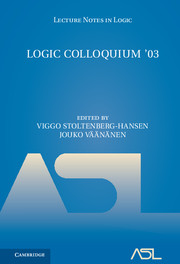Book contents
- Frontmatter
- Contents
- Introduction
- Colloquium Program
- TUTORIAL
- RESEARCH ARTICLES
- Indestructibility and strong compactness
- Some applications of regularmarkers
- Has the continuumhypothesis been settled?
- Geometry of interaction IV: the feedback equation
- On local modularity in homogeneous structures
- Descriptive set theory and uncountable model theory
- Decidable properties of logical calculi and of varieties of algebras
- Stabilization — an alternative to double-negation translation for classical natural deduction
- Definability and reducibility in higher types over the reals
- Predicativity problems in point-free topology
- Rank inequalities in the theory of differentially closed fields
- Consistency and games— in search of new combinatorial principles
- Realizability for constructive Zermelo-Fraenkel set theory
- On long EF-equivalence in non-isomorphic models
- The theory of is undecidable
- Cocovering and set forcing
- References
Indestructibility and strong compactness
from RESEARCH ARTICLES
Published online by Cambridge University Press: 30 March 2017
- Frontmatter
- Contents
- Introduction
- Colloquium Program
- TUTORIAL
- RESEARCH ARTICLES
- Indestructibility and strong compactness
- Some applications of regularmarkers
- Has the continuumhypothesis been settled?
- Geometry of interaction IV: the feedback equation
- On local modularity in homogeneous structures
- Descriptive set theory and uncountable model theory
- Decidable properties of logical calculi and of varieties of algebras
- Stabilization — an alternative to double-negation translation for classical natural deduction
- Definability and reducibility in higher types over the reals
- Predicativity problems in point-free topology
- Rank inequalities in the theory of differentially closed fields
- Consistency and games— in search of new combinatorial principles
- Realizability for constructive Zermelo-Fraenkel set theory
- On long EF-equivalence in non-isomorphic models
- The theory of is undecidable
- Cocovering and set forcing
- References
Summary
Abstract. We construct a model in which the first two strongly compact cardinals aren't super-compact yet satisfy significant indestructibility properties for their strong compactness.
Introduction and preliminaries. The study of indestructibility for non-supercompact strongly compact cardinals is one which has been the subject of a great deal of investigation over the last few years, most notably in the papers [1, 6, 7, 3], and [15]. We refer readers to the introductory section of [3] for a thorough discussion of the relevant history. We note, however, that in spite of all of the work done, the basic question of whether it is consistent, relative to anything, for the first two strongly compact cardinals to be non-supercompact yet to satisfy significant indestructibility properties for their strong compactness had heretofore been left unanswered. This should be contrasted to the relative ease with which Laver's forcing of [18] iterates, to produce models such as the one given in [1] in which there is a proper class of supercompact cardinals and every supercompact cardinal κ has its supercompactness indestructible under directed closed forcing.
The purpose of this paper is to provide an affirmative answer to the above question. Specifically, we will prove the following theorem.
THEOREM 1.1. It is consistent, relative to the existence of two supercompact cardinals, for the first two strongly compact cardinals and to be non-supercompact yet to satisfy significant indestructibility properties for their strong compactness. Specifically, in our final model VP, strong compactness is indestructible under arbitrary directed closed forcing, and strong compactness is indestructible under either trivial forcing or directed closed forcing that can be written in the form.
We note that Theorem 1.1 is a generalization of a sort of Theorem 1 of [3]. In the model constructed for this theorem, the first two strongly compact cardinals and aren't supercompact (and in fact, are the first two measurable cardinals), strong compactness is fully indestructible under directed closed forcing, yet measurability, but not necessarily its strong compactness, is indestructible under arbitrary directed closed forcing.
- Type
- Chapter
- Information
- Logic Colloquium '03 , pp. 27 - 37Publisher: Cambridge University PressPrint publication year: 2006
References
- 1
- Cited by



